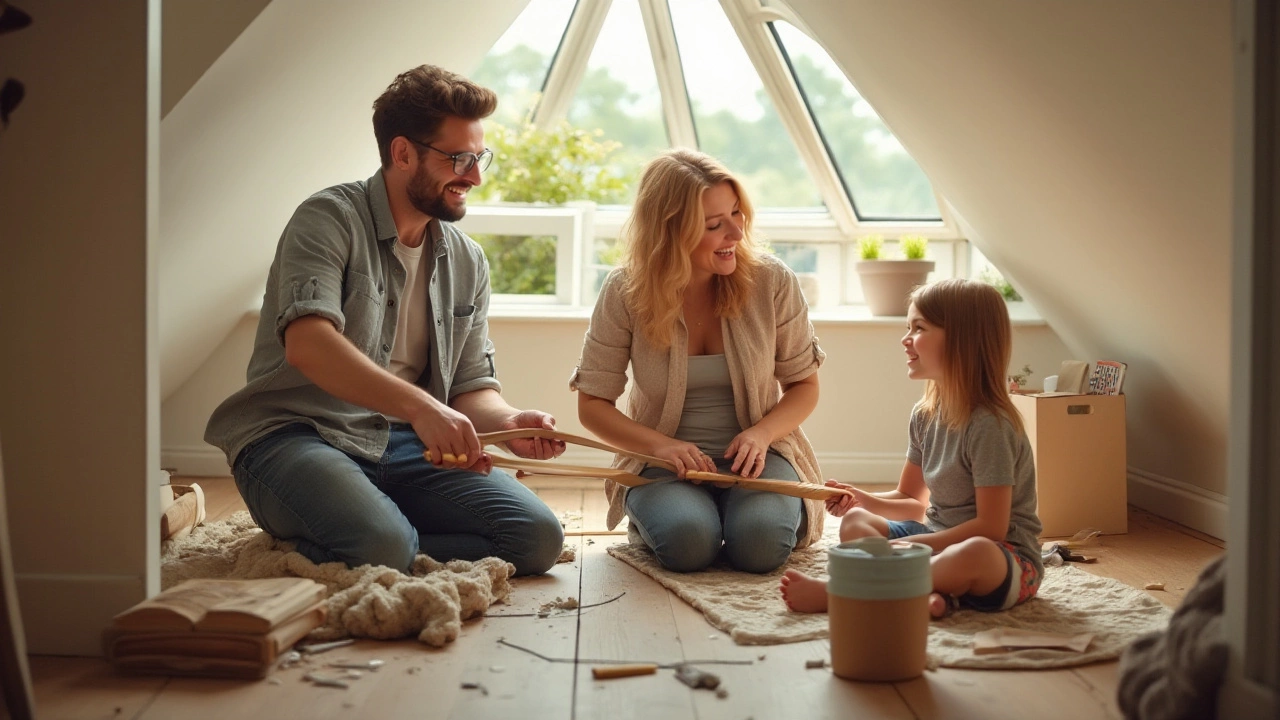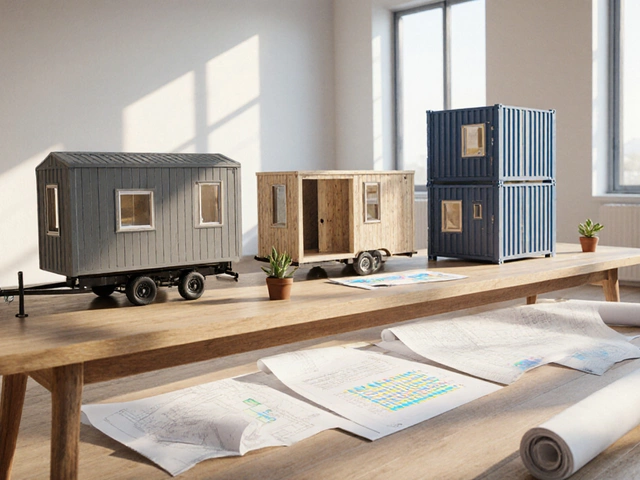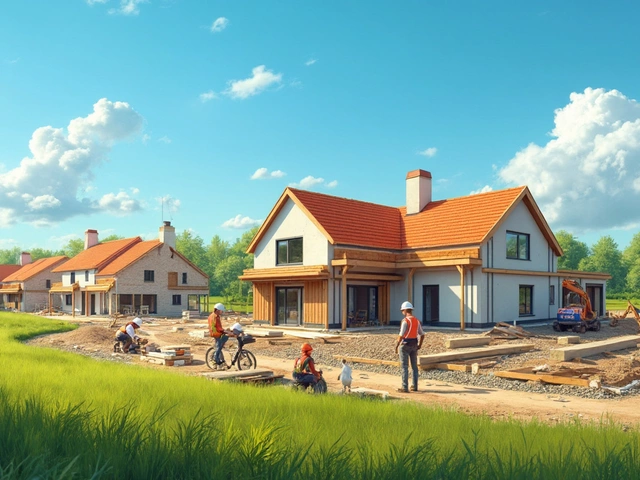When you're living in a space that feels a tad too cramped, extending your house might be an enticing idea. But taking on a major renovation often leads to questions about costs and affordability. How can one expand their living area without facing financial stress?
This article delves into practical methods for achieving a budget-friendly house extension. From tapping into the potential of existing structures to exploring economical construction methods, a bit of inventive thinking and strategic planning can go a long way in saving money.
Whether you're pondering a kitchen overhaul or dreaming of a backyard annex, it's important to consider all your options. Exploring materials that offer both durability and affordability and hiring skilled professionals who understand your financial constraints can make a significant difference.
- Why Extend?
- Budget Planning
- Using Existing Structures
- Affordable Materials
- Hiring the Right Help
- Alternative Construction Methods
Why Extend?
Choosing to extend your home is a decision rooted in a multitude of personal and practical reasons, often driven by the need to accommodate a growing family or a desire for more functional living spaces. As families evolve, so do their space demands, and a well-thought-out house extension offers a viable solution without the upheaval of relocating. It is not just a matter of increasing square footage but also enhancing the home's functionality and aesthetic value. Whether it's about creating a dedicated home office, adding a playroom for the children, or simply expanding the kitchen to make it more open and inviting, the motives are as varied as they are compelling.
Financially, the option to extend can be more cost-effective than purchasing a new home, when you factor in the costs associated with buying, selling, and moving, not to mention the emotional toll of leaving a beloved neighborhood or disrupting children's schooling. Property experts suggest that strategic home upgrades can significantly boost a property's market value, often recouping the investment and then some if you're smart about the improvements. A well-designed extension can transform not just your property's layout but also its appeal, particularly if it integrates seamlessly with existing structures and landscapes. Interestingly, a study by the National Association of Realtors found that about 75% of homeowners reported a greater desire to be at home after completing a renovation or addition, underscoring the emotional impacts of extending one's home.
Extending your home also provides an opportunity for customization that goes beyond the limits of existing housing markets. You can tailor every detail to suit your needs, from the size and purpose of each new room to the colors, materials, and finishes used. It's an exercise in creating a space that truly reflects one's personality and lifestyle. Architect Sarah Susanka points out, "A well-designed extension can one one's home more liveable and enjoyable, enhancing natural light, improving flow, and creating an inviting atmosphere." Capturing natural light, improving energy efficiency, and adopting sustainable building practices in your extension can deliver additional rewards in terms of well-being and reduced utility costs. Each choice made during the design and build process represents an opportunity to enhance family life, increase comfort, and possibly even generate long-term savings.
Budget Planning
Venturing into the realm of house extensions without a well-thought-out budget is akin to setting sail without a compass. It's essential to lay out a detailed financial plan right from the start, which will help manage expenditures and avoid any unpleasant surprises as the project unfolds. A useful starting point is to calculate how much you are willing to invest in the project. Thoughtfully consider elements like the scope of the extension and the value it will add to your property. Remember, setting a realistic budget can help steer the project smoothly from conception to completion.
Begin by evaluating your current financial situation and what resources are at hand. This could include savings, potential loans, or even assistance from family. It may be wise to consult with a financial advisor or project manager who specializes in renovations, as they can provide a clear picture of what's feasible within your means. Prioritizing tasks can help ensure critical aspects are covered first, while less essential desires can be revisited when there's flexibility in the budget.
“Preparation, I have often said, is rightly two-thirds of any venture.” – Amelia Earhart
A comprehensive budget should account for both direct and indirect costs. Direct costs include expenses for materials, labor, permits, and equipment rental. Indirect costs, often overlooked, might cover design fees or any temporary living arrangements if you need to vacate the premises during the renovations. Adding a buffer to your estimated costs is also prudent, typically around 10-20% of the total projected expenses, to accommodate unexpected contingencies that could arise during the project.
If you're considering a loan to fund the project, it's crucial to shop around for the best rates and repayment terms. Evaluate various loan products from banks and credit unions and consider the total cost of borrowing, including interest rates and any additional fees. Remember, affordability doesn't just pertain to the initial cost; it's about sustaining payments in the long term without sacrificing your standard of living. Balancing aspirations with financial realism is essential in budget planning for a successful outcome.
| Cost Aspect | Estimated Percentage of Total Budget |
|---|---|
| Materials | 40% |
| Labor | 35% |
| Permits and Fees | 10% |
| Contingency | 15% |
Another aspect of budgeting involves leveraging tools and resources that help keep track of expenses and timeline. There are various apps available, such as Mint or You Need A Budget (YNAB), which can assist in monitoring expenditure against what's been outlined in your plan. Many of these applications allow for real-time updates and adjustments, providing a clear snapshot of your financial standing at every stage of the extension process. Embracing technology for planning can streamline the financial aspect and avoid any potential budgetary mishaps.
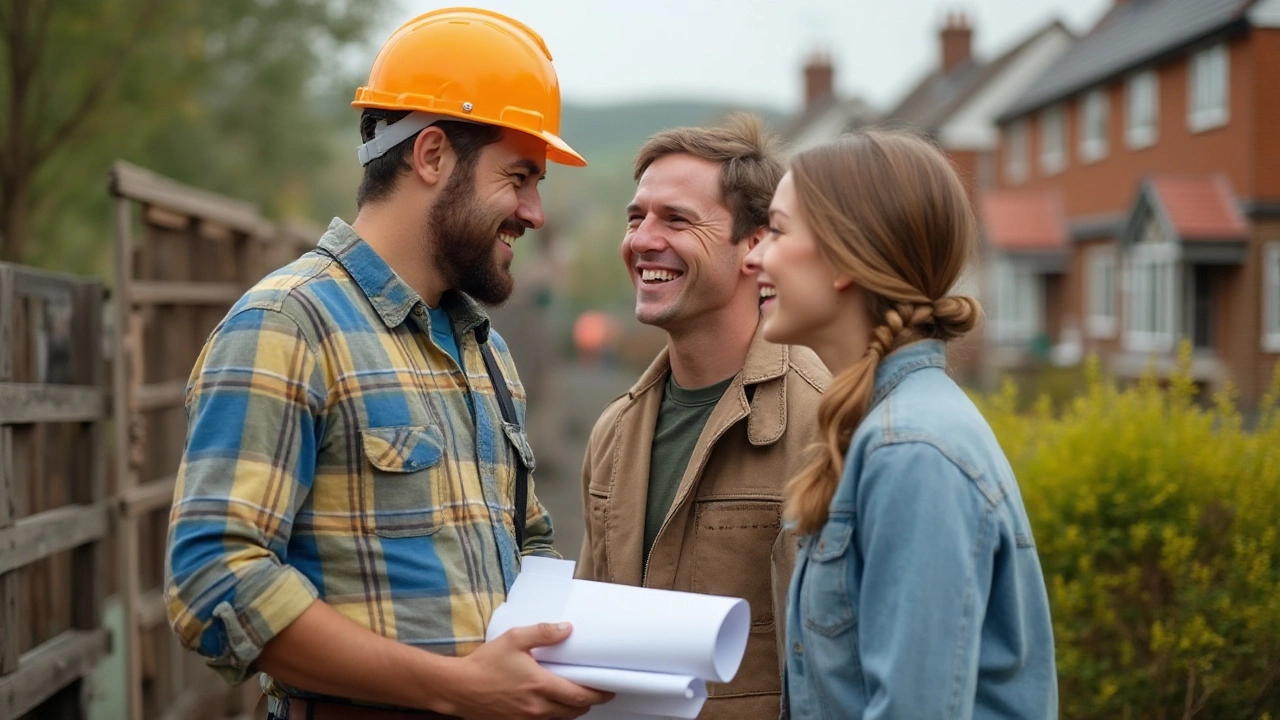
Using Existing Structures
Maximizing the use of existing structures in your home is not only an economical choice, but it also offers potential savings on time and effort. One common application of this approach is transforming attics into livable loft spaces. Often, the attic is an underutilized area, which in many homes, dwindles away as mere storage. By converting your attic into a cozy retreat or an additional bedroom, you can significantly boost the utility of your home while staying on a budget. This kind of renovation might involve reinforcing the flooring, adding insulation, and introducing skylights to increase natural light, all of which are cost-effective compared to building a new addition entirely.
Basements represent another ambitious yet rewarding project when considering extensions within existing structures. Converting a basement can offer a variety of options—be it a playroom, home office, or even a rental suite for generating income. The key to a successful conversion lies in ensuring the space is dry and well-ventilated. This might mean tackling issues with dampness or potentially waterproofing the foundation. Such preparatory measures, though apparently daunting, come with lower overall costs than extensive exterior renovations.
Garages often harbor untapped potential for extension. If you don't require dedicated vehicle space, converting a garage can add significant square footage to your living area. In fact, according to experts, transforming a standard garage can add about 400 square feet of usable space to your home at a fraction of the cost of a new construction. You might be surprised to learn that garages can evolve into a seamless extension of your home, serving as a new family room, gym, or studio. To maintain a cost-effective home improvement, it’s crucial to consider the existing layout and how changes might integrate seamlessly.
According to a report by HomeAdvisor, the national average cost to finish a basement is around $18,000 in 2023, which is significantly less than constructing an outdoor addition. Responsible for such lower costs are the foundational and infrastructural elements already in place. The report noted, "Homeowners save on crucial expenses like roofing, siding, and foundational structures by repurposing existing space."
As you embark on these projects, abiding by building codes and standards is necessary, which might initially seem like a challenge. Hiring professionals who are adept at transforming existing spaces can alleviate such concerns while simultaneously ensuring the work is up to your expectations. A savvy contractor will not only understand your budget-friendly renovations but also offer innovative solutions that align with structural integrity and local regulations.
Expanding home space doesn't always necessitate extensive builds or exorbitant expenses. Instead, thoughtful modifications to existing structures provide practical solutions with the added benefit of retaining your property’s character. Whether you're looking to make space for a growing family, create a dedicated work area, or simply enhance your home's value, using existing structures opens up a realm of possibilities that can honor both your vision and your wallet.
Affordable Materials
When planning a house extension, the choice of materials can play a significant role in keeping your budget in check. Opting for cost-effective home improvements doesn't mean you have to compromise on quality. In fact, the market offers a range of materials that are affordable yet durable, allowing you to achieve a stunning result without breaking the bank. One excellent option is recycled materials, which not only help the environment but also come at a fraction of the cost of new materials. Reclaimed wood, for instance, brings character and warmth to a home extension while contributing to sustainability. It's worth checking local suppliers or online marketplaces for such finds.
Another cost-saving choice for your house extensions is light gauge steel. It's a versatile and strong alternative to timber, often available at a lower price point. Since it's lighter, it reduces the need for heavy foundations, cutting back on construction expenses. Moreover, steel is termite-resistant and less prone to warping, ensuring longevity and less maintenance over time. Imagine the satisfaction of knowing that you're investing in materials that don't just look good now, but will continue to function well and look appealing years down the line.
Concrete panels also represent a great way to save money while expanding your home. With advancements in prefabrication, these panels offer quick installation, significantly reducing labor costs. You might be surprised to know how versatile they can be, accommodating various designs and finishes. Their energy efficiency is another plus point, helping you save on heating and cooling costs in the long run.
A simple yet effective alternative involves exploring local resources. Materials such as adobe or rammed earth, common in some regions, can provide a unique aesthetic while eliminating the cost of transporting materials from afar. Their thermal mass properties enhance energy efficiency, providing natural insulation against extreme temperatures. Using locally sourced stone similarly enhances the location's character while minimizing costs.
Don't forget modern composite materials such as fiber cement siding, which combines wood pulp, sand, and cement to create a material that's both weather-resistant and low-maintenance. This product mimics the appearance of traditional wood siding without the susceptibility to rot or pests, making it perfect for budget-friendly renovations.
Jane Hutton, an architecture professor, once stated, "The future of building materials is not only in their inherent resilience but in how well they'll integrate into the existing ecosystem sustainably."Her words underscore the importance of choosing materials with both cost and the environment in mind.
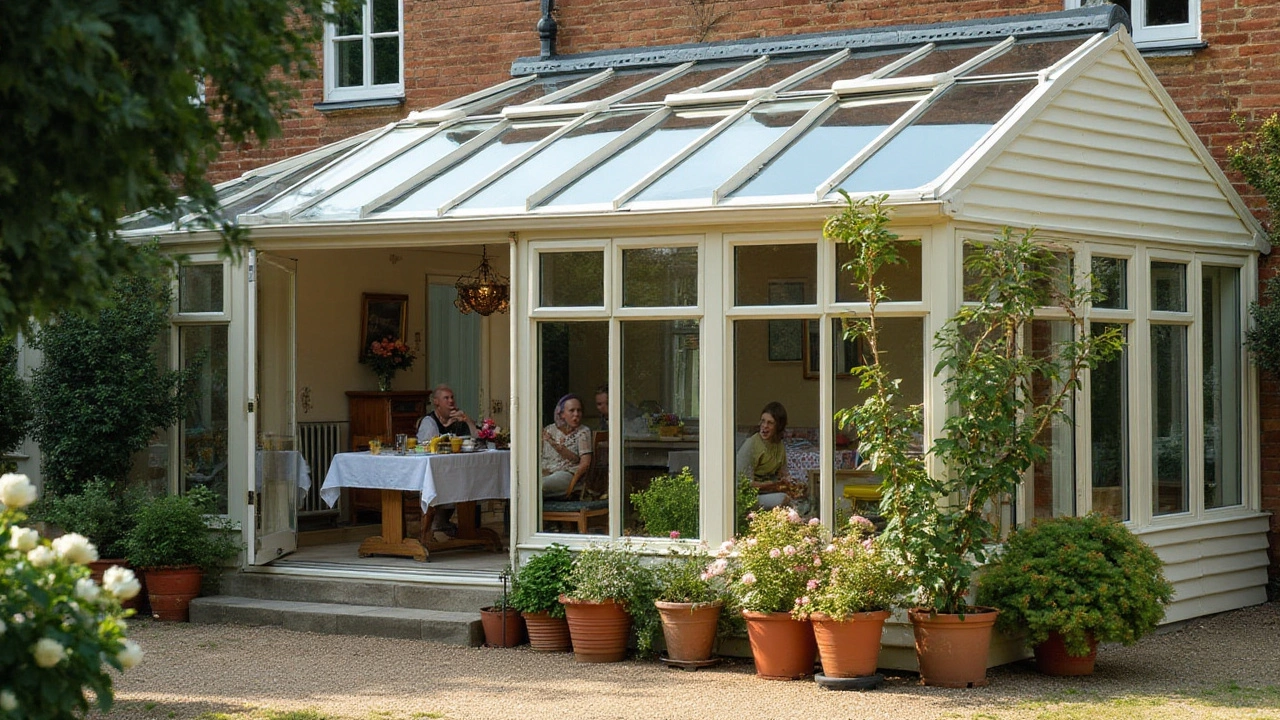
Hiring the Right Help
When planning a house extension on a tight budget, one crucial factor that can determine the success of your project is hiring professionals who are not only skilled but also understand your financial limitations. The world of home renovations is dotted with experts, each bringing a unique set of skills to the table. Finding the right team involves more than just checking credentials; it requires a thorough understanding of their hands-on experience, ability to deliver within budget constraints, and their knack for offering creative solutions using cost-effective methods.
Start by gathering recommendations from friends or neighbors who have recently undertaken similar projects. Word of mouth can often lead you to reliable professionals who value delivering quality without inflating costs. It's also wise to check platforms that rate and review contractors. Detailed reviews can provide invaluable insights into a contractor's reliability, craftsmanship, and perhaps most importantly, their flexibility in working with limited budgets.
Interview multiple contractors before making a decision. During these meetings, inquire about their previous experience with budget-friendly renovations. A genuine professional will not shy away from sharing instances where they have effectively balanced quality with cost. It's essential to gauge their enthusiasm and creativity when it comes to exploring alternative construction methods and affordable materials. During one such conversation, a contractor might suggest, "Consider modular construction—it often saves both time and money while being sustainable." This approach could lead to substantial savings as modular methods involve prefabricated segments that reduce labor time on-site. Also, ask for a breakdown of potential costs and a preliminary timeline for the project. Transparency here is key; vague estimates could lead to financial surprises down the line.
Remember to verify if the contractor is licensed and insured. These credentials are vital in safeguarding your investment, providing peace of mind that if things go awry, you're protected. Insurance also implies a level of professionalism and seriousness about their work, which is crucial especially when one's working with cost-effective home improvements. Also, discuss the payment structure early on. Many professionals will propose a percentage of the cost upfront with subsequent payments tied to project milestones, ensuring work is completed to your satisfaction at each stage.
If you're more adventurous, consider hiring a project manager or a construction consultant. They can oversee the minutiae of the project, keeping both the timeline and budget in check. A seasoned manager often pays for themselves through the efficient management of resources and effective negotiation with suppliers and subcontractors. They bring together a team that operates like a well-oiled machine, reducing delays and cost overruns.
By carefully selecting your team, you're setting a foundation for a successful, budget-friendly house extension. This decision impacts every aspect of the project—from the use of affordable materials to adherence to the timeline—and lays down the basics for potential cost-saving measures. Hiring wisely ensures that your vision of a more spacious home doesn't just remain a dream but turns into a reality without straining your finances.
Alternative Construction Methods
When it comes to house extensions, thinking outside the box can lead to smarter, more cost-effective solutions. Alternative construction methods are gaining traction among homeowners who yearn for efficient, yet budget-friendly renovations. These methods have proven to be not only creative but incredibly scalable as well, adjusting to varied budgets and design sensibilities. Whether you're adding a small room or building a substantial extension, these innovative techniques can be tailored to fit your specific needs.
The modular building has emerged as a top contender in alternative construction. These prefabricated structures are constructed off-site in logical parts and then transported to your home, where they are assembled swiftly. This process reduces waste, minimizes outdoor labor time, and ultimately slashes costs. A 2022 study revealed that modular constructions could reduce building time by up to fifty percent compared to traditional methods, equating to substantial savings. By adopting this path, homeowners gain the dual advantage of economic building practices alongside enhanced flexibility and personalization options.
If modular isn't up your alley, another fascinating approach is green construction. This goes beyond just materials—it's a commitment to creating extensions that harmonize with the environment while being kind to your wallet. Envisage an abode where rooftop gardens provide thermal insulation, or strategically placed windows harness natural light, reducing the need for artificial lighting during the day. Such designs can significantly cut down energy bills over time. Incorporating reclaimed materials into your construction can reduce expenses, blending sustainability with aesthetic uniqueness. For instance, using recycled steel supports or reclaimed wood flooring can create a stunning centerpiece for your home, all while keeping costs in check.
As quoted by renowned architect and sustainable design advocate Sarah Susanka, "The notion of economy in design isn't about sacrificing quality or beauty. Sustainable, resource-smart building can actually enhance a home's charm and function while ensuring it's economically viable." These inspiring methods reflect that sentiment, showing that stretching square footage doesn't have to stretch your finances.
One more option that deserves mention is the fascinating world of 3D printing in construction. Though relatively nascent, this technology is rapidly revolutionizing the industry. 3D printing can create entire sections of construction material, thus dramatically reducing the time taken for a build. A report in 2023 emphasized how this technology could lower costs by up to thirty percent due to reduced labor and material wastage. As the tech matures, it's anticipated to become a more mainstream method for homeowners seeking efficient and cost-effective extensions.
The magic of alternative construction methods lies in their ability to blend creativity with practicality, offering a harmonious balance between dreams and actual savings. Exploring these cost-effective home improvements leads to possibilities that are as delightful to imagine as they are to live in. Whether you're piecing together modular components or planting an eco-friendly oasis atop your roof, these options offer a tangible path to a home that expands elegantly, resonating with both your lifestyle and your budgetary constraints. Taking a strategic approach to your extension with these methods is not just smart; it's a trend worth considering for anyone who values both their environment and their resources.

